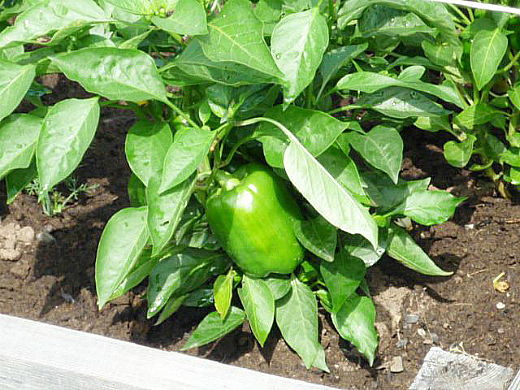 Some gardeners and breeders argue that self-growing peppers is a science. However, more and more people are starting to hold a different point of view. Indeed, it is not enough to plant pepper and just wait for the harvest.
Some gardeners and breeders argue that self-growing peppers is a science. However, more and more people are starting to hold a different point of view. Indeed, it is not enough to plant pepper and just wait for the harvest.
It requires some care, and its integral part is top dressing. What loves pepper, how and when to feed it, as well as the features of using the safest folk remedies, we will consider in the article.
Content
What loves sweet pepper
Pepper is a relatively unpretentious culture, but only if all the necessary conditions are created for its growth and development. It is very important for him to have a constant supply of moisture and air, and therefore the soil must be selected not only fertile, but also loose. It is very important that it contains a sufficient amount of nitrogen and potassium. Additional components for normal life are phosphorus, magnesium and calcium, but chlorine only causes harm, so its presence should be minimized, and it is better to completely abandon it.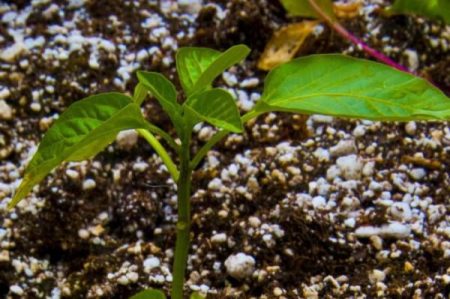
Much depends on the state of the root system, therefore, emphasis should be placed on root dressing and only when the plant grows, budding, flowering and ovary begin, and attention is paid to the aerial parts.
When to feed
Most pepper is demanding on nutrition. But excessive feeding can only do harm. Before fertilizing, you need to find out when it is advisable to do.
At first, pepper receives sufficient nutrition for development from the soil, but the substances contained in it quickly deplete, and then the time comes for the next work.
The first time top dressing is carried out at the age of 10-14 days. One of the most popular is a solution prepared from ½ tsp. urea, sodium humate and a liter of water.
The next time the pepper receives additional nutrition 10 days after the first feeding. At this point, it should already have 4-5 real leaves. This time, a solution is prepared from ½ tsp of urea, potassium monophosphate and a liter of water.
Also, during the growth of seedlings, it is recommended to carry out root and foliar top dressing at least twice.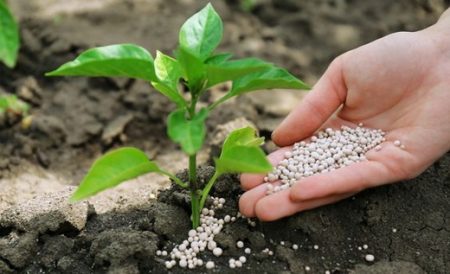
Most often, mullein and bird droppings are used for this. The first is dissolved with water in the proportions of 1: 5, the second - 1:10.
The next feeding according to the schedule is carried out on the 15th day after transplanting into the ground. At this point, the first flowers should appear. This time, organic fertilizers or minerals can also be used if none are available.
After a couple of weeks, when the ovaries begin to form, again you need to feed the pepper. The last time, with the normal development of plants, fertilizers are applied a week before the harvest. However, if the fruits are small, if the stems are weak and sluggish, you can carry out another top dressing. Just remember that the substances used must be alternated. If you constantly use organic or mineral substances, there will be no sense from them.
You can buy ready-made fertilizers in any specialized store, but still it’s safer and more reliable to use folk remedies. Consider the most popular of them.
Folk remedies
The popularity of folk remedies is due to a combination of their availability, safety and effectiveness.But this is only if you use them in accordance with all the rules.
Yeast
Recently, yeast is increasingly found in the shopping list of not only culinary specialists, but also gardeners.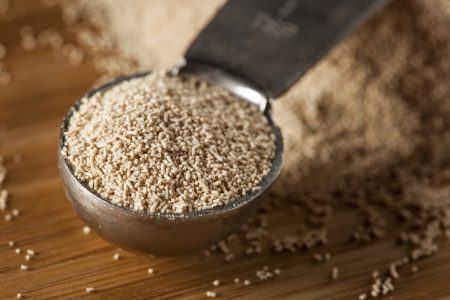
They are an excellent fertilizer for plants, stimulate their growth and normalize development, increase endurance, accelerate root formation, etc.
The work of yeast is explained by the content of fungi in them, which perfectly take root in the soil of any composition, significantly increase its nutritional value, stimulate the activity of active microorganisms, and contribute to faster processing of organics in the soil.
The main advantage of yeast is its high content of nitrogen and phosphorus, but in addition to these components necessary for the full development of plants, they are enriched with many vitamins, minerals, iron, and other equally important components.
Fresh yeast is diluted in kilogram proportions per 5 liters of water and left for 5 days in a warm place. After the resulting infusion is diluted in 50 liters of water and plants are watered under the root.
Dry yeast (50 g) is mixed with sugar and poured into a bucket of water. Need to insist less. Two hours is enough. Before use, the resulting solution must be diluted with water (1:20).
There are a few yeast-based recipes that you can use to feed pepper:
- For 70 liters of water you will need a bucket of freshly cut grass, a pound of rye crackers and as much live yeast.
- In 5 liters of water dissolve a handful of earth, a table. a spoonful of dried yeast, 2 tablespoons of sugar and 2 g of ascorbic acid.
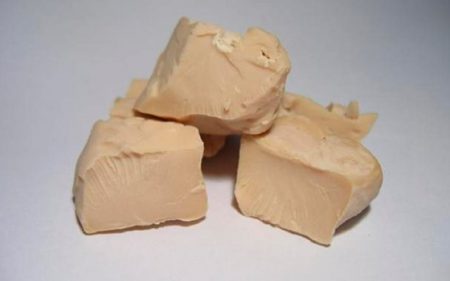
If yeast is not at hand, you can get it yourself. For this, crackers, leftover bread or any other flour infusion are suitable. Here are just a few of the proven recipes:
- sprout wheat grains, take 2 tablespoons in a glass of the resulting mass. liters of sugar and as much flour. Grind everything, put in a pan with non-stick coating and bring to a boil over low heat. Boil for 15-20 minutes. Then leave for several days until fermentation begins. Before use, mix with 10 liters of water;
- a glass of hop cones (you can use both dry and fresh) pour 1.5 liters of boiling water, boil over low heat for about an hour. Cool, strain, add 2 tables. l sugar and flour and leave for several days before fermentation. As soon as the process begins, dissolve in 10 liters of water and use to feed pepper;
- boil two medium-sized potatoes until half cooked, cool and grate with a peel. Add a table. spoon of sugar, mix and leave for a day in the warm. As soon as signs of fermentation appear, you can dilute 1: 5 with water and apply as fertilizer.
The prepared fertilizer can be used no more than twice a season and it must be applied exclusively to warm soil. It should be borne in mind that expired yeast for cooking is not suitable. The effect can be exactly the opposite.
There is only one minus in the use of yeast - the solutions prepared on their basis destroy potassium in the soil. To avoid its deficiency, the use of this type of top dressing must be carried out together with wood ash.
Wood ash
How often do we find out that real wealth was literally under our feet, but simply was not used for its intended purpose.
For example, wood ash. This is one of the best organic fertilizers. The main advantages are a high content of phosphorus and potassium, and in a form that significantly increases the digestibility of their plants.
In addition, it contains a lot of magnesium, iron, zinc, calcium and sulfur. Ash strengthens the immunity of plants, makes them more resistant to fungal diseases.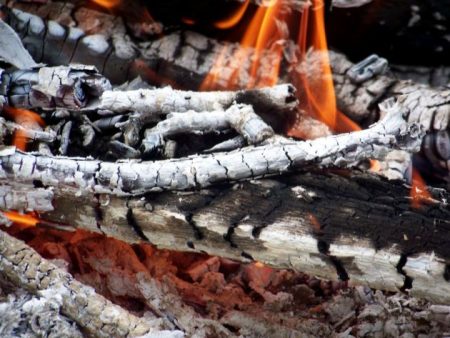
You can use ash without fear, but only with nitrogen-containing substances it is not worth combining it.There will be no harm to plants from this, but there will be no sense either.
Ashes are introduced into the soil before transplanting seedlings into it. 2 tables are placed in each well. l, you just need to remember that in contact with ash, tender roots can get burns. Therefore, a layer of earth must also be poured on top of the ash.
In the future, ash can be added to the aisles, sprinkled earth around the holes, and also used for irrigation. To do this, you need 100 grams of ash per bucket of water. Around the plant, you need to make a small groove and pour the resulting solution into it. For one feeding, half a liter is enough.
Use this natural remedy for foliar treatment. To do this, pour 300 grams of ash into 3 liters of water and boil for 25-30 minutes. After diluting in 10 liters of water and add 50 grams of finely grated laundry soap. The plant is sprayed in dry, calm weather so that the solution is evenly distributed over the leaves and stem.
You can also carry out dry dusting. The effect will be the same as after spraying, only less long.
Wood ash is very important for pepper. In addition to the necessary trace elements, there is absolutely no chlorine in it, which the plant does not like so much.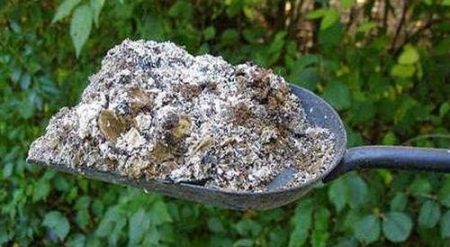
Root dressing can be done 2-3 times per season, and foliar - 2 main times, as well as 3-4 times a month, when pepper is actively growing, and buds are formed on it.
Banana skin
They say that good owners do not throw away anything. Banana skins are an excellent confirmation of this. Enterprising citizens have found a lot of uses for them. They are used both for brushing teeth and for updating the appearance of shoes, and are actively used as fertilizers.
It turns out that there is a lot of potassium, calcium and phosphorus in a banana peel.
The best fertilizer will turn out if you soak the banana skins in water, leave until complete decomposition, and then use for watering under the root. However, the smell during cooking is such that not everyone is able to make it. But do not immediately abandon this treasure. There are other ways.
You can chop the banana peel and bury it in the ground. After that, even the weakest and frailst sprouts will come to life right before our eyes, become more magnificent, abundant flowering will begin. Such feeding is enough for about three weeks.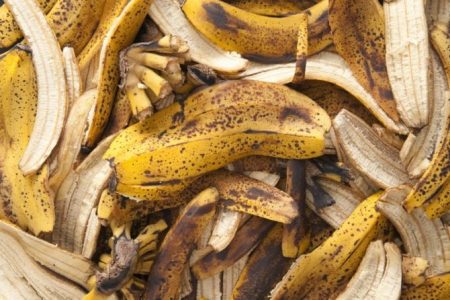
The second way to use the peel is more original. To prepare the fertilizer, it must be fried. To do this, lay the skins on foil and put in the oven until it is well browned. After cooling, grind and add a spoon to the root of each plant. If you cook for the future, store in an airtight container.
You can pour three banana skins with three liters of water and leave for two days. Strain the resulting infusion, dilute in half with water. Watering can be done once a week.
And also such an infusion of banana peel repels aphids perfectly. Be sure to try to spray them with plants if they are exposed to such a misfortune.
It is possible to increase soil fertility by drying the skins on a battery, then grinding them and adding them to the soil.
Winter bananas are much more useful, so you can prepare them for the future, just freezing in the refrigerator.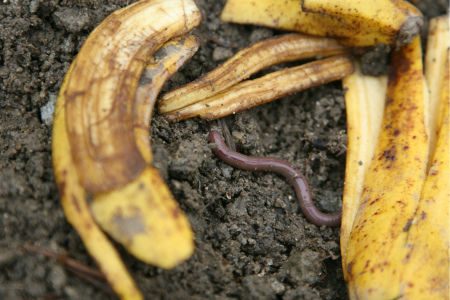
Banana peel is an excellent fertilizer, but do not forget to wash it thoroughly and pour over boiling water. Remember that overseas fruit is treated with chemicals to extend its shelf life and storage.
Boric acid
Boric acid can also be used to feed pepper. It is especially important during flowering and ovary formation. Also, its regular use prevents possible rotting of the fruit.
It is noted that such top dressing increases productivity, significantly improves the taste characteristics of fruits.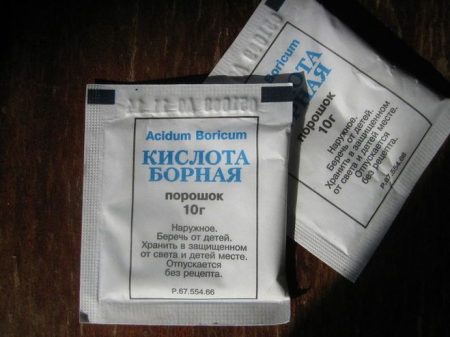
First of all, it is recommended to use this product as a fertilizer when growing pepper at home (on the balcony or window sill). Boric acid helps to create such plants as close to natural conditions as possible.
In addition to replenishing the supply of nutrients, the prevention of late blight infection also occurs, only if you choose boron, do not use superphosphates in parallel. But potassium permanganate, soda and laundry soap in combination with this tool is even recommended.
Boron helps plants to recover well after an illness. Also, with its help, you can reduce the risk of death of seedlings during a dive.
The first time the treatment is carried out before sowing the seeds. For this, a solution is prepared from a half liter of onion husk decoction, 0.02 g of boric to-you and several potassium permanganate granules. Seeds need to be soaked for 2-3 hours. This will help not only make plants more resilient, but also reliably protect them from late blight.
During the ripening period of the bud, the appearance of color and the formation of ovaries, pepper is sprayed. For this, a teaspoon of acid is dissolved in a bucket of water and evenly distributed using a spray bottle. About a liter of solution is used per square meter of land.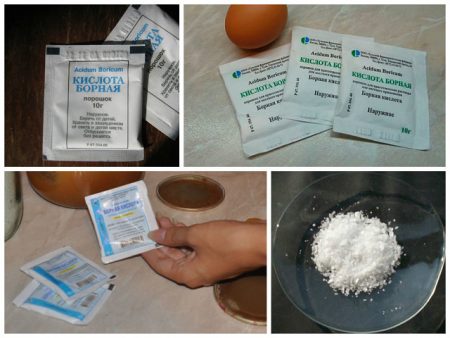
Root dressing is carried out if there are clear signs that the plant is not enough boron. This can be determined by the pale upper leaves, by the loss of leaf shape, by weak flowering and shedding of the ovaries. Also, "starvation" can occur during fruiting. Then small fruits, loss of shape, twisting, rotting can let know about it.
Watering is carried out with a solution of 0.1 g of boron and a liter of water. To prevent a possible burn, first you need to water the bush with plain water, and then gradually add fertilizer.
Watch the reaction of pepper. If the leaves begin to turn yellow and fall, bend with a dome and spin up, this may be a sign of an excess of boron.
Boric acid is not only an excellent growth stimulator and an assistant in increasing soil nutrition. It is a proven antiseptic and insecticide for years. Use it wisely, do not exceed the dosage, and the pepper harvest will only please. Do not forget about individual methods of protection. Boric acid is harmless to humans, birds and animals, but inhalation of vapors is not recommended, so be safe.
Eggshell
Egg shells, together with other waste, are in most cases sent to the bin. Unless occasionally, drawing on the experience of past years, it is used when planting potatoes to protect it from the bear.
In fact, this is a valuable fertilizer that can be used, among others, for feeding pepper. This elementary tool allows you to significantly increase productivity and get much more fruits, even from the first season.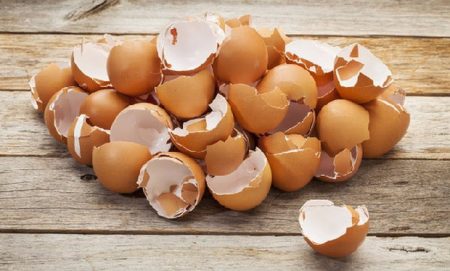
Many people think that simply distributing the shell on the surface of the soil is enough. But in the end, not only is there no sense, but also the birds fly with such bait with pleasure and destroy the landing at the same time.
There are certain rules for collecting eggshells. Received from raw eggs are laid out on cardboard and left to dry. It is important that it is stored in a warm and dry place. The film on the shell should not deteriorate, namely dry. On average, it takes 3-5 days.
If the shell is collected from a boiled egg, there will be no sense from the film and it needs to be removed.
After you need to stretch the shell and put it in paper bags. For grinding, you can use a rolling pin, a coffee grinder or a meat grinder. The smaller the pieces, the better the fertilizer.
On the basis of the eggshell, you can cook a combined product for feeding pepper. To do this, it is first baked in an oven, mixed with ash, and then ground. The resulting fertilizer will be richer in calcium, phosphorus, potassium and magnesium.
The easiest way is to fertilize directly into the soil. But for additional nutrition, you can prepare liquid fertilizer. Fill the jar with chopped shells by a third and pour water to the top, close the lid and put it in a dark place. The process takes about 10-14 days. The water will become cloudy and acquire a very unpleasant odor.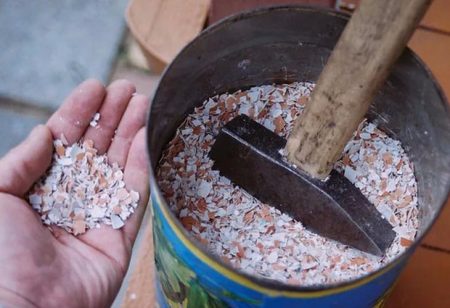
The infusion should be filtered and diluted with water 1: 3, and then used for irrigation.
The liquid agent can be used for top dressing during the period of active growth, budding, flowering and fruiting. It is able to save the landing from the "black legs". It is only necessary to detect the affected plant in time, remove it and water the rest with infusion.
Egg shells can also be used during bed preparation in the fall. It is enough to sprinkle it on the surface of the soil before digging. Such a simple tool will make the soil more loose.
The best fertilizer is obtained from the shell of domestic eggs, but if they are not available, you can use store-bought ones.
Egg shells are used not only in folk practice, even in large farms it is increasingly used. More recently, it was discovered that it is able to neutralize the harmful effects of the used agrochemicals and increase the benefits they bring.
A shell of eggs can and should be used to feed pepper, but questions arise about quail eggs. Today, it is not exactly clear whether the fertilizer prepared on their basis is useful, so it is better to use proven methods.
Onion peel
Onion peel is often used to protect garden residents from pests, from diseases, but they are almost never considered as fertilizer in vain! In addition to the disinfecting properties, it contains a lot of useful trace elements. An excellent result is given by adding it to the soil on a bed that is being prepared since autumn or to the soil, which is used for growing seedlings.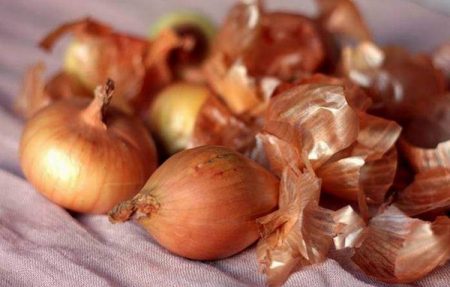
Onion peel disinfects, destroys fungi, microbes and pathogenic bacteria. And the decoction and infusion prepared on its basis support the plant, help it get the maximum benefit from the soil, stimulate the formation of flowers and ovaries.
The broth is prepared by falling asleep in a bucket of water a few handfuls of onion husks. On low heat, bring to a boil, cover and leave to cool completely. Then strain and use for watering or spraying.
There is another recipe. You can fill half a bucket of husk with water to the top, leave for a week to insist. After filtering, add 50 g of laundry soap, mix. Before spraying, dissolve in half with water. This will not only provide the necessary supply of nutrients, but also reliably protect against aphids and other parasites and fungi.
Grass
Weed control is an integral part of garden work.Someone gives the grass to hens or other animals, someone dries and burns, and someone knows how to cook from it an excellent fertilizer, which is also suitable for pepper.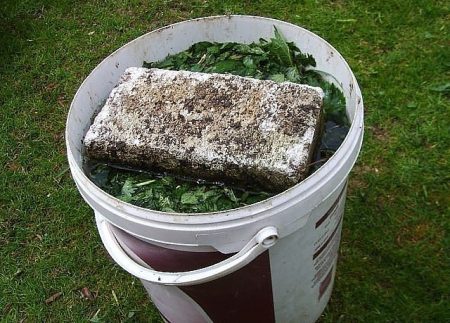
For cooking, you need a large barrel, grass and water. We spread the grass in a barrel, fill it with water and leave it in the sun until fermentation. You can speed up the process by adding a little yeast. Fertilizer is ready for use as soon as the smell appears, like manure.
Yes, the aroma is still the same, but the effect after watering is simply amazing. Once a week, a glass for each bush and the result will not be long in coming. The bushes will become more luxuriant, the productivity will increase significantly, and the fruits will not only be tastier, but will also be easier to tolerate transportation and withstand storage.
Top dressing in the open ground and in the greenhouse
Pepper can be grown in open ground, hotbeds and even at home.
Plants grown on balconies or window sills need top-dressing. They need to be fed more often than garden ones. All of the above methods are suitable for this. To create a more fertile soil, you can use fertilizers from banana, to increase the friability of the soil - egg shells, to maximize approximation to natural conditions - boric acid, to protect against pests - a decoction of onion husks.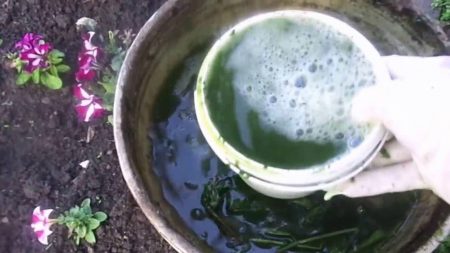
Greenhouse plants can also be fertilized with all of the listed means, only this should be done much less often, only if the need arises. You can use the shell for the soil and to protect the bushes from slugs, you can add banana skins, dust with ash and sprinkle it along the beds. But for onion broth, another use is suggested. Pick up convenient containers, put onion husks on them, fill them with hot water and place them all over the greenhouse. Vapors will be in the air and it is with him that the plant will receive all the nutrients and the necessary protection.
You have already learned the methods of feeding pepper in the open ground earlier in the article.
Reviews
Alevtina Nikolaevna, 52 years old
I myself do not grow pepper seedlings, I buy ready-made ones. The beds are loosening in the autumn, I fall asleep with leaves, then in the spring my husband digs up. I tried last year to first drop the siderats. I liked the result. The soil becomes more loose and significantly enriched with nitrogen. During the cultivation I use fertilizer from herbs fermented, and also spray with a soap solution and onion broth.
Maria Tifonovna, 67 years old
For many years in a row I have been using proven methods of feeding pepper. When planting, I always put the shells in each hole, after which I sprinkle onion husks around the bush from above. I do not spend spraying, unless the aphid starts attacking, but then I use household soap. I’ve heard about a banana peel for the first time, but I’ll definitely try to use it. If the sprouts begin to weaken, I pour them with sweet water (2 tablespoons per liter of water) once a week.
Alena, 26 years old
I have neither a summer house nor a garden, therefore I am very glad to the breeders who bred the seeds of vegetables for growing at home. I have a real garden on the balcony. If you properly take care of the plantings, then you can get fresh vegetables for your family. I grow tomatoes and cucumbers all year round, but I tried pepper for the first time. The Bulgarian did not work, but the sharp took root, however, the fruits are small, and the bush itself is miniature, but the taste is much more intense.
Want to get a higher pepper crop this year? Try the suggested feeding methods. All methods have been tested repeatedly and, if used correctly, are extremely beneficial.




 Calorie pepper stuffed with meat and rice - BZHU per 100 grams
Calorie pepper stuffed with meat and rice - BZHU per 100 grams Gorky pepper - the best varieties for open ground
Gorky pepper - the best varieties for open ground Hot pepper seeds - the best varieties for open ground and reviews
Hot pepper seeds - the best varieties for open ground and reviews Capsicum tincture for hair - how to use and reviews
Capsicum tincture for hair - how to use and reviews